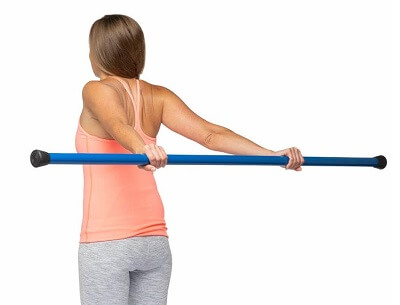- Home
- Shoulder Exercises
- Mobility Exs
Shoulder Mobility Exercises
Written By: Chloe Wilson BSc (Hons) Physiotherapy
Reviewed By: SPE Medical Review Board

Shoulder mobility exercises help to loosen up the shoulder, decrease pain and improve arm movement.
There may be stiffness after an injury or surgery, or it may have gradually developed over time.
Whether you are just starting out, or are looking for more of a challenge, these shoulder mobility exercises will help.
The shoulder is the most mobile joint in the body being able to twist, glide and stretch in all directions. But any issues in the shoulder can soon lead to stiffness which can make it painful and awkward to move.
Best Shoulder Mobility Exercises
These shoulder mobility exercises will help you to regain the movement in your arm without risking further injury. But do always consult your doctor before starting any new exercise regime – it is important to have an accurate diagnosis to ensure that shoulder pain exercises are appropriate.
You will find three groups of shoulder mobility exercises here:
- Pendulum Exercises: improve shoulder mobility without putting any strain through the shoulder muscles
- Pulley Exercises: increase shoulder mobility using simple pulley systems
- Assisted Exercises: support the weight of the affected arm during exercises to increase shoulder mobility
Choose the ones that best suit you depending on what is wrong with your shoulder.
1. Pendulum Exercises
Pendulum exercises are the perfect shoulder mobility exercises to start with if you have injured your shoulder or your shoulder is feeling particularly stiff and sore to move. Normally, to move the arm, pairs of muscles work together to contract and relax to bring about arm movement. But if there is a problem with the muscles e.g. a strain or tear, it can be really painful to move the arm as the damaged muscles are having to do the work.
With pendulum shoulder mobility exercises, the muscles don’t have to do any work at all, so there is no stress through them. Instead, gravity works to move the arm while the muscles remain relaxed.
Shoulder Swings
Purpose: First stage shoulder mobility exercises to improve movement without working the msucles
Starting Position: Stand next to a table with your legs apart. Lean forwards, resting your good arm on the table and let your sore arm hang down, completely relaxed.
Action: Gently shift your weight from side to side (movement coming from your pelvis) and let your arm follow the movement, moving like a pendulum. Keep the movement rhythmical and your arm relaxed
Repetition: Spend 1-2 minutes doing this 2-3x daily
Variations: You can change the direction the arm moves in by changing how you shift your body:
- Side to Side: as described above
- Circles: draw circles first clockwise and then anticlockwise
- Forwards and Backwards: Start with your legs in a lunge position (have the same leg forwards as the arm you are moving) and gently rock forwards and backwards
Progression: You can get the shoulder moving more by leaning further forwards as you do the exercise – you will notice that the further forwards you lean, the further away from your body your arm hangs because the shoulder is more flexed
2. Pulley Shoulder Exercises
Pulleys are a great way to improve movement in a stiff shoulder and are perfect for shoulder mobility exercises because:
- you get a good, rhythmical movement at the shoulder
- the other arm helps to increase the movement at the shoulder by pulling on the pulley
- you can choose how much work your muscles do – either keep them completely relaxed and let the arm follow the movement, or get the muscles to start doing some of the work themselves.
Safety Advice: Make sure you fix the pulley firmly to the door before starting any pulley shoulder mobility exercises.
Shoulder Flexion With Pulley
Purpose: Improve shoulder flexion - lifting the arm forwards and above your head
Starting Position: Sit on a chair, facing the door. Take hold of one handle in each hand at head height
Action: Slowly pull down on the pulley with your good arm, so that your affected arm raises forwards and upwards without any effort. Then slowly let the affected arm come down, controlling the movement with the pulley so the movement is nice and controlled
Repetition: Repeat 20-40 times, 2x daily
Internal Rotation With Pulley
Purpose: Improve internal rotation - twisting the arm inwards such as reaching behind your lower back
Starting Position: Stand sideways with your good arm nearest to the door. With your affected arm, reach behind your lower back and take hold of one handle (buttock height). Hold the other handle in your good hand, around shoulder height
Action: Pull down and forwards on the pulley with your good arm, so that the hand on your affected arm glides up your back until you feel a stretch. Then slowly bring the hand back down, controlling the movement with the pulley
Repetition: Repeat 20-40 times, 2x daily
Shoulder Abduction With Pulley
Purpose: Improve abduction - bringing your arm out to the side away from your body and up above your head
Starting Position: Side or stand with your back to the door. Hold one handle in each hand so your affected arm rest down by your side, palm facing forwards and the other arm is above your head
Action: Gently pull down with the good arm so that your affected arm rises up and out to the side as high as is comfortable until you feel a stretch. Then slowly lower the arm back down, controlling the movement with your good arm
Repetition: Repeat 20-40 times, 2x daily
Top Tips With Pulleys
For all of these pulley shoulder mobility exercises:
- Make sure you keep your upper body upright, don’t lean over
- You can add an extra stretch by holding the stretch position for a couple of seconds before relaxing down
- Try and gradually pull the arm slightly higher as it loosens out, but don’t force in to pain
Best Shoulder Pulleys
If you don’t already have one, you can buy a door pulley and rig it up at home – they are very simple to use and cheap to buy.
Our favourite ones are the Range Master and 66Fit door pulleys. They are easy to set up - simply hang them over your door, and they receive great user reviews 4.6/5
Read: User Reviews Buy Now: On Sale (guide price $13/£7)
3. Assisted Shoulder Mobility Exercises
Assisted exercises are the next step with shoulder mobility exercises. The weight of the arm is supported so that you are getting movement at the shoulder with minimal effort from the muscles.
You can choose how much support you give the arm – start by fully taking the weight so that the good arm is doing all the work and your sore arm is simply following the movement, and progress by gradually reducing the amount of support so that the affected arm starts to lead more of the movement.
Assisted Shoulder Flexion
Purpose: Improve shoulder flexion - bring the arm forwards and upwards
Starting Position: Sitting or lying down, support the arm to be moved underneath the elbow or at the wrist with your good hand
Action: Gently lift the arm forwards and up as if you were reaching above your head. Only go as far as is comfortable. Hold for a moment and slowly lower back down
Repetition: Repeat 10-25 times 1-2x daily
Top Tips: Having your affected elbow bent as you do this exercise will make it easier
Assisted Shoulder Abduction
Purpose: Improve shoulder abduction - reaching out to the side away from your body
Starting Position: Sitting or standing, hold a stick in both hands with the palm of your affected hand rest on one end of the stick (handle is easier to grip than the bottom end)
Action: Slowly push the stick out to the side, so that the stick lifts your sore arm away from your body. Only go as far as is comfortable. Hold for a moment and slowly lower back down
Repetition: Repeat 10-25 times, 1-2x daily
Top Tips: Keep your upper body still, don’t let it tip over to the side
Towel Stretch
Purpose: This helps to improve medial/internal rotation at the shoulder, where the joint twists inwards such as reaching behind your lower back.
Starting Position: Standing. Hold a towel in your good hand and drape it over your good shoulder, letting it hang down your back. Grab the bottom of the towel with other hand (affected side)
Action: Gently pull the towel upwards with your good arm, so that your other hand slides up your back as far as is comfortable
Repetition: Repeat 10-25 times, 1-2x daily
Top Tips: 1. Keep your shoulder and shoulder blades drawn back as you do this, don’t let them drop forwards
2. Keep your upper body upright – don’t bend forwards
Wall Walking
Purpose: Improve shoulder flexion - lifting the arm forwards and up using the wall to support the weight of your arm
Starting Position: Stand, facing a wall. Rest your fingers on the wall at hip height (sore arm)
Action: Slowly “walk” your finger up the wall as far as is comfortable. Hold for a couple of seconds and slowly lower
Repetition: Repeat 10-25 times, 1-2x daily
Progression: 1. On the way down, only walk your fingers down as small way to ease of the stretch rather than coming all the way back down to hip height
2. At the top of the movement, hold for a few seconds and then try and “walk” up slightly further before lowering down
3. Hold at the top of the movement and then step towards the wall – this should bring your hand up slightly higher
Ball Rolls
Purpose: These shoulder mobility exercises get the shoulder muscles initiating and controlling the movement without having to support the weight of the arm. The movement of the ball can also help you to reach that little bit further
Starting Position: Stand facing a table with your hand resting on top of a large ball
Action: Gently roll the ball forwards as far as you can so your arm reaches forwards and your elbow is straight. Hold for a moment and roll the ball back
Repetition: Repeat 10-25 times, 2x daily
Variations: The method described above helps to improve shoulder flexion but you can also use the ball to improve abduction (taking your arm out to the side). Simply turn to the side so your affected arm is next to the table and place your hand on top of the ball. Roll the ball away so that your arm moves out to the side
What Else Can Help?
Shoulder mobility exercises are a great place to start to regain the movement at the shoulder. Once you can perform all these exercises easily, you may find it helpful to do some more intense shoulder stretches to fully stretch the muscles out – visit the arm stretches section to get started.
It can also help to strengthen the shoulder so that it moves in a smooth, controlled, pain-free way. Choose from the following:
- Rotator Cuff Exercises
- Scapular Stabilization Exercises
- Resistance Band Shoulder Exercises
- Upper Back Stretches
- Trapezius Stretches
And remember, it is really important to know what is causing your shoulder pain so check out the common shoulder problems or shoulder pain diagnosis sections before starting the shoulder mobility exercises.
Page Last Updated: 22/03/2022
Next Review Due: 22/03/2024













